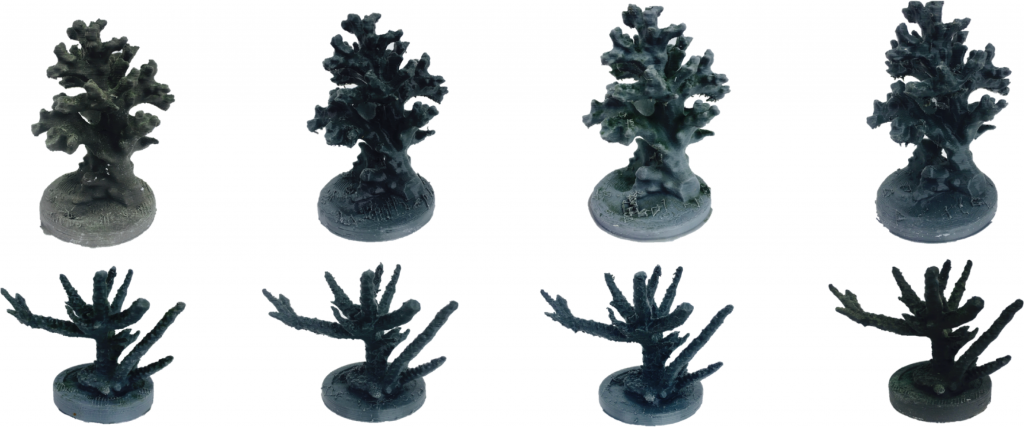Researchers from the School of Marine Science and Policy at the University of Delaware are looking further into the concept of 3D printed models placed in the vicinity of coral and fish, touching on concerns regarding toxicity and chemical leaching. In the recently published ‘3D printed objects do not impact the behavior of a coral-associated damselfish or survival of a settling stony coral,’ authors Emily J. Ruhl and Danielle L. Dixson outline their findings regarding the use of 3D printed models in coral reef behavioral research.
 Previous research has been performed regarding 3D printed objects in the environment with success, from studying animal behavior and habitat to using 3D printed shells to offer stability to oyster beds. And you don’t have to live on an island or near the beach to be aware that coral reef systems are in trouble today—often with little left of their once-thriving habitats. Ruhl and Dixson see great potential in 3D printing for ‘advancing the discipline of coral reef behavioral ecology.’
Previous research has been performed regarding 3D printed objects in the environment with success, from studying animal behavior and habitat to using 3D printed shells to offer stability to oyster beds. And you don’t have to live on an island or near the beach to be aware that coral reef systems are in trouble today—often with little left of their once-thriving habitats. Ruhl and Dixson see great potential in 3D printing for ‘advancing the discipline of coral reef behavioral ecology.’
For this study, the team experimented with the use of 3D printed and natural skeletons placed amidst blue-green chromis, along with researching the survival rate of Caribbean mustard hill coral on a 3D printed substrate. In creating the models, they photographed the coral from 50 different angles, using a simple iPhone. After converting the files into 3D designs, they printed the models to life-size dimensions on the following variety of 3D printers:
The researchers then acclimated the 3D printed models in seawater for a week, after which a ‘cafeteria-style arrangement’ was set up:
“All five coral treatments of a single species were arranged in a circular pattern spaced 50cm apart from the corals directly adjacent in a 1.8m diameter tank filled to 45cm. For each trial, coral species and treatment order were randomized. An individual fish was placed into an 18cm diameter mesh cylinder (1cm2) at the center of the experimental tank and left to habituate for 15-minutes (A. formosa n = 29, P. damicornis n = 15). The cylinder’s construction allowed the fish to observe all habitat treatments without having access to them. After the habituation period, the cylinder was slowly raised to begin the 15-minute observation period.”

Replicates of P. damicornis (top) and A. formosa (bottom) control corals 3D printed with nGen, XT, PLA, and SS filament, respectively.
The authors recorded the habitat non-stop, and overall discovered that experimenting with 3D printed objects in situ rendered benign results, demonstrating suitability for assessment of a range of reef behaviors and habits.
“As coral reef ecosystems are highly dynamic environments, field studies are the next step to investigate the efficacy of using 3D printed objects to facilitate ecological research,” concluded the authors.
“While coral settlement studies in situ are typically not disruptive to coral reef systems, 3D printed substrate could allow for novel methodologies in conducting this research. For instance, printed substrate could be designed to compare settlement rates, growth, and survival of different coral species across specific surface complexities or cryptic microhabitats. This information could inform management practices by tailoring efforts to the needs of individual species.”
While many users and researchers today are concerned about the impact of 3D printing on the environment, the technology has been used in many different projects behind helping to save it, from preparing to rid the ocean of plastic waste to removing pollutants from the air and even stopping food waste.
What do you think of this news? Let us know your thoughts! Join the discussion of this and other 3D printing topics at 3DPrintBoard.com.

Mean behavioral responses (± SE) by C. viridis when exposed to 3D printed or coral skeleton habitats (n = 12).
[Source / Images: ‘3D printed objects do not impact the behavior of a coral-associated damselfish or survival of a settling stony coral’]
The post How Effective are 3D Printed Reefs? appeared first on 3DPrint.com | The Voice of 3D Printing / Additive Manufacturing.






